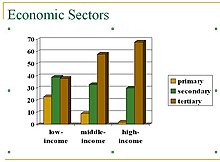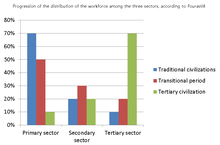經濟部門
外觀



- 第一產業:涉及原料和生產,例如玉米、煤炭、木材和鐵礦開採。(煤礦工人、農民或漁民是第一產業工人。)
- 第二產業:涉及將原材料或中間材料轉變為商品,例如將鋼鐵製造成汽車,或將紡織品製造成服裝。(建築工人和裁縫屬於第二產業工人。)
- 第三產業:涉及向消費者和企業提供服務,例如育嬰、電影業和銀行業。(店主和會計師是第三產業的工人。)
到了20世紀,經濟學家開始認為,傳統的三級服務可以進一步區分出「第四產業」和「第五產業」的服務業部門。第四產業部門的經濟活動包括基於信息和知識的服務,而第三產業服務包括人類服務和招待性行業相關的產業。[2]
歷史演變
[編輯]一個經濟體可能包括幾個連續階段發展起來的部門(也稱為「產業」):
- 傳統經濟主要建立在自給農業基礎上。
- 工業革命降低了自給農業的作用,在過去三個世紀中將土地利用轉變為更粗放的單一耕作農業形式。經濟增長主要發生在採礦、建築和製造業中。
- 在現代消費者社會的經濟中,服務、金融和技術(知識經濟)扮演着越來越重要的角色。
與發達國家相比,即使在近代,發展中國家仍更傾向於依賴前兩個部門。
按所有權
[編輯]經濟也可以按照不同的所有權劃分:
參見
[編輯]參考文獻
[編輯]- ^ Zoltan Kenessey. The Primary, Secondary, Tertiary and Quaternary Sectors of the Economy (PDF). The Review of Income and Wealth. [20 April 2012]. (原始內容存檔 (PDF)於2012-03-11).
Regarding the terminology itself Clark informs that "the term tertiary industries was originated by Professor A. G. B. Fisher in New Zealand, and became widely known through the publication of his book, The Clash of Progress and Security, in 1935. It took its origin from the titles current in Australia and New Zealand of 'primary industry' for agriculture, grazing, trapping, forestry, fishing and mining, and 'secondary industry' for manufacture. In Australia and New Zealand these terms are not only used in statistical reference books but are widely current in popular discussion. The phrase 'tertiary industries' therefore immediately carries, in these countries, a suggestion of those excluded by the official definition of 'secondary industries."
- ^ Matt Rosenberg. Sectors of the Economy. About.com. 14 January 2007 [20 April 2012]. (原始內容存檔於2016-11-19).
